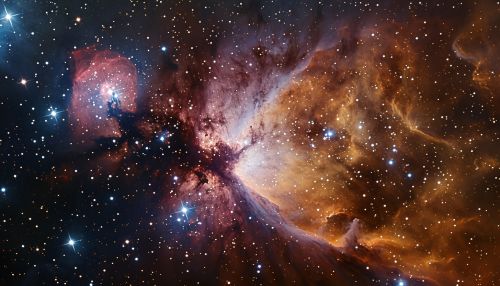Nebular hypothesis
Origins and Historical Development
The Nebular Hypothesis is a widely accepted model explaining the formation and evolution of the solar system. It suggests that the solar system formed from nebulous material, hence its name. The theory has evolved significantly since it was first proposed in the 18th century by Swedenborg, Kant, and Laplace.


The initial concept was based on observations of the solar system and the assumption that the laws of physics have remained unchanged over time. It was further developed and refined in the 19th and 20th centuries, incorporating new discoveries and theories in astronomy, physics, and geology.
Theoretical Framework
The Nebular Hypothesis is based on the principles of conservation of angular momentum and gravitational collapse. According to the hypothesis, a nebula - a large cloud of gas and dust - collapsed under its own gravity. As the nebula collapsed, it began to spin and flatten into a disk, with most of the mass concentrated in the center. This central mass became the sun, while the rest of the material in the disk formed the planets, moons, asteroids, and other bodies in the solar system.
The process of collapse and disk formation is believed to have taken place over a few million years, a relatively short time in astronomical terms. The subsequent formation of the planets and other bodies took considerably longer, up to several hundred million years.
Evidence and Observations
The Nebular Hypothesis is supported by a wide range of observations and evidence. These include the motion and distribution of bodies in the solar system, the composition of the sun and planets, and the existence of other disk-shaped star systems.
One of the key pieces of evidence is the observation that all the planets orbit the sun in the same direction and in roughly the same plane. This is exactly what would be expected if the planets formed from a rotating disk of material.
Another important piece of evidence is the composition of the sun and planets. The sun contains more than 99% of the mass of the solar system, but it is made mostly of hydrogen and helium, the lightest elements. The planets, on the other hand, contain heavier elements, which are more abundant in the outer parts of the disk.
The existence of other star systems with disks of material, both in the process of forming and already formed, provides further support for the Nebular Hypothesis. These systems, observed with telescopes and other instruments, show the same kind of structure and behavior predicted by the hypothesis.
Challenges and Controversies
Despite its wide acceptance, the Nebular Hypothesis has faced several challenges and controversies. Some of these have led to modifications and refinements of the hypothesis, while others have spurred the development of alternative theories.
One of the main challenges is explaining the formation of the giant planets, such as Jupiter and Saturn. These planets are made mostly of hydrogen and helium, similar to the sun, but they are located in the outer solar system, where these elements are less abundant. Several solutions have been proposed, including the idea that the giant planets formed closer to the sun and then migrated outward.
Another challenge is explaining the existence of planets around binary stars and stars with highly elliptical orbits. These systems are difficult to explain with the standard Nebular Hypothesis, which assumes a single, central mass and a circular orbit.
Despite these challenges, the Nebular Hypothesis remains the most widely accepted model for the formation of the solar system. It provides a comprehensive and coherent explanation for a wide range of observations, and it has been successful in predicting new discoveries.
Implications and Applications
The Nebular Hypothesis has important implications for our understanding of the universe. It suggests that the process of star and planet formation is common and that there could be many other solar systems in the universe.
The hypothesis also has practical applications. It guides astronomers in their search for exoplanets and helps scientists understand the potential for life on other planets. By studying the process of planet formation, we can gain insights into the conditions that might support life.
